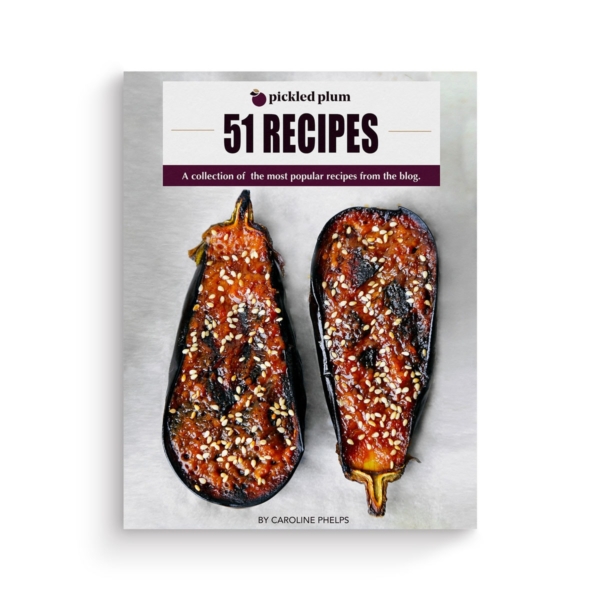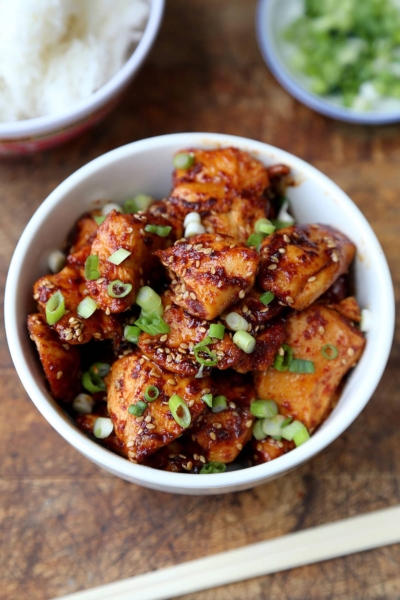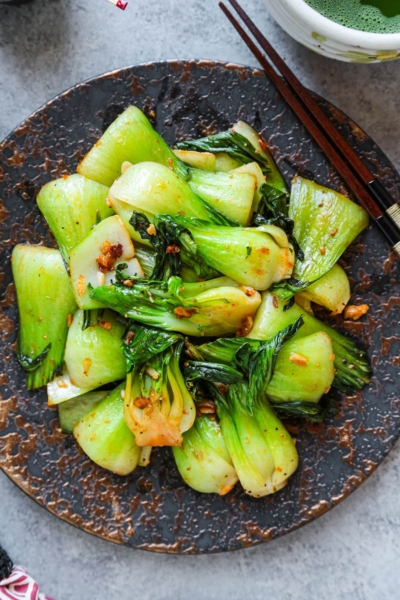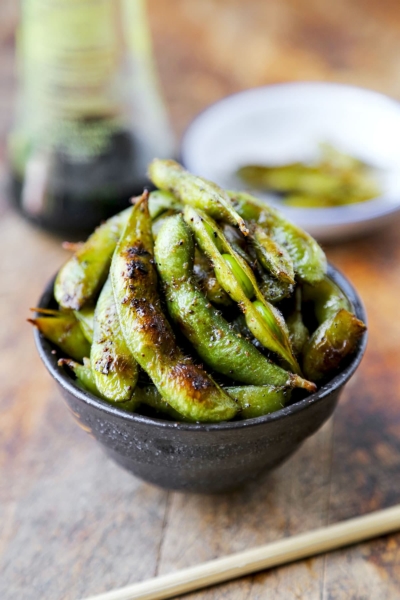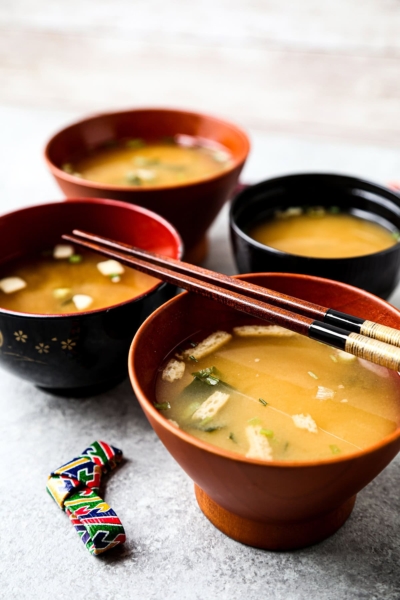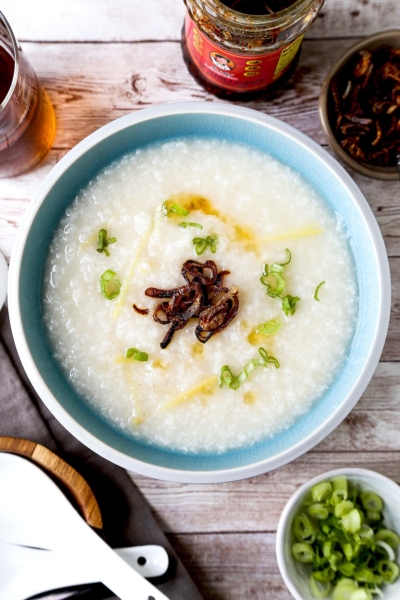I make my smoky shrimp chow mein to be a show stopper. Springy shrimp with just a little char on them, mixed with crisp bok choy and sprouts lays a solid foundation. But it’s the noodles themselves that blow me away – chewy with just the right amount of smoky ‘wok hei’ (or wok breath). They’re the overdrive machine. Ready in 25 minutes, start to finish.
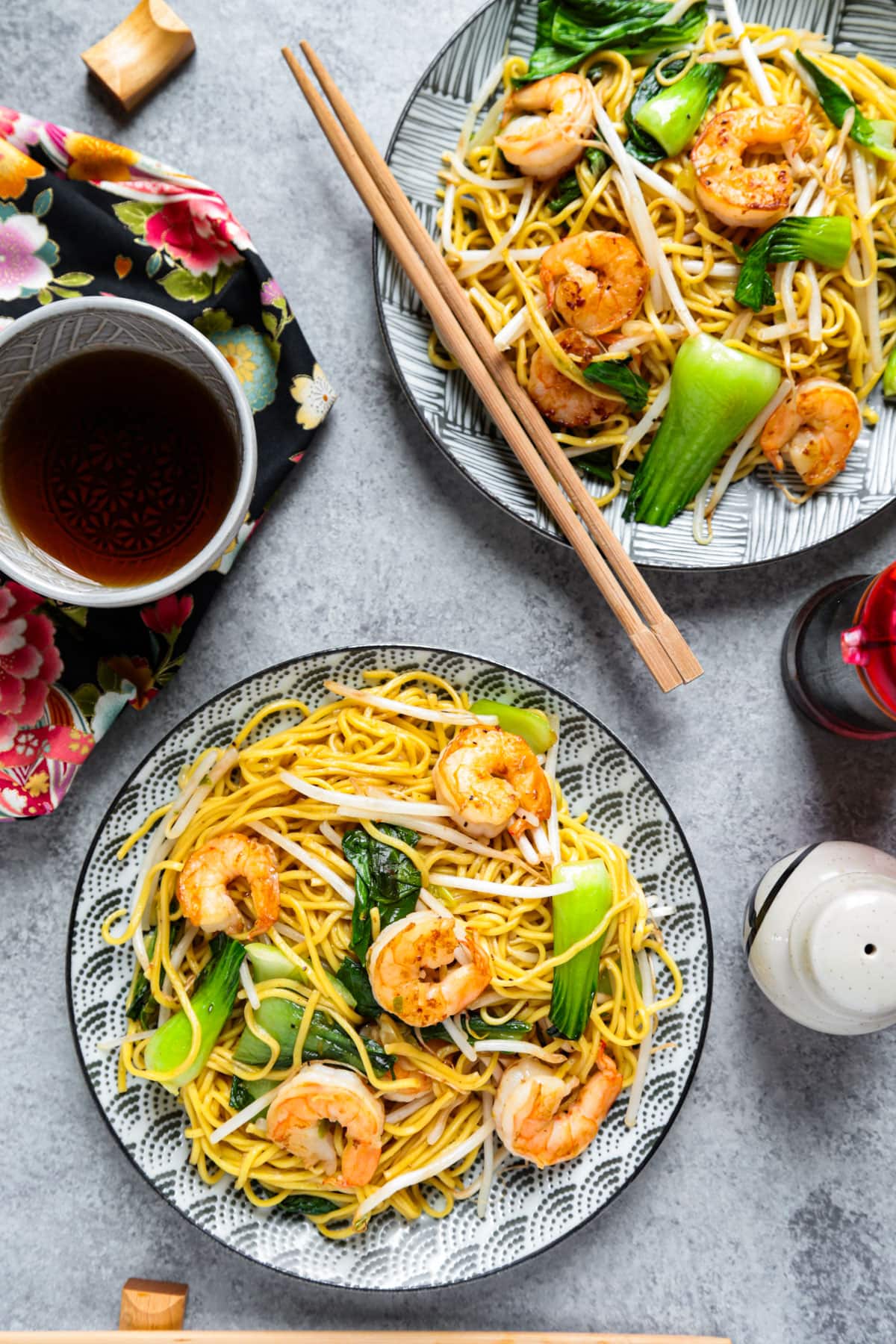
The first bite (directly out of my wok!) told me everything I needed to know about my shrimp chow mein. The shrimp itself was so springy that it actually popped when I bit into it. My bok choy had a tender crispness – and I love crunchy sprouts in anything. But it was the noodles I was most interested in. I’ve found that’s where many restaurant versions go off the rails; they under-season and underwhelm. Well, my chow mein had that trademark smoky, wok-fired essence. And the noodles were full of savory, sweet, peppery umami throughout. That flavor comes down to a simple 5 ingredient sauce.
One of those ingredients I rely on in particular for these noodles (and Chinese stir fries in general) is shaoxing wine. It’s a rice wine that is briny, sweet, sharp and dry. I lean on it heavily to make everything from my Chinese eggplant with garlic sauce to bok choy with oyster sauce – all the way to other Chinese noodle dishes like lo mein. Unsurprisingly, shaoxing wine worked wonders in my shrimp chow mein – making it more restaurant quality than many restaurants. I asked my husband to try a bite, with the intention of saving the rest for dinner later that evening. But we ate it all right then and there, standing by the stovetop, directly from the pan.
Table of Contents
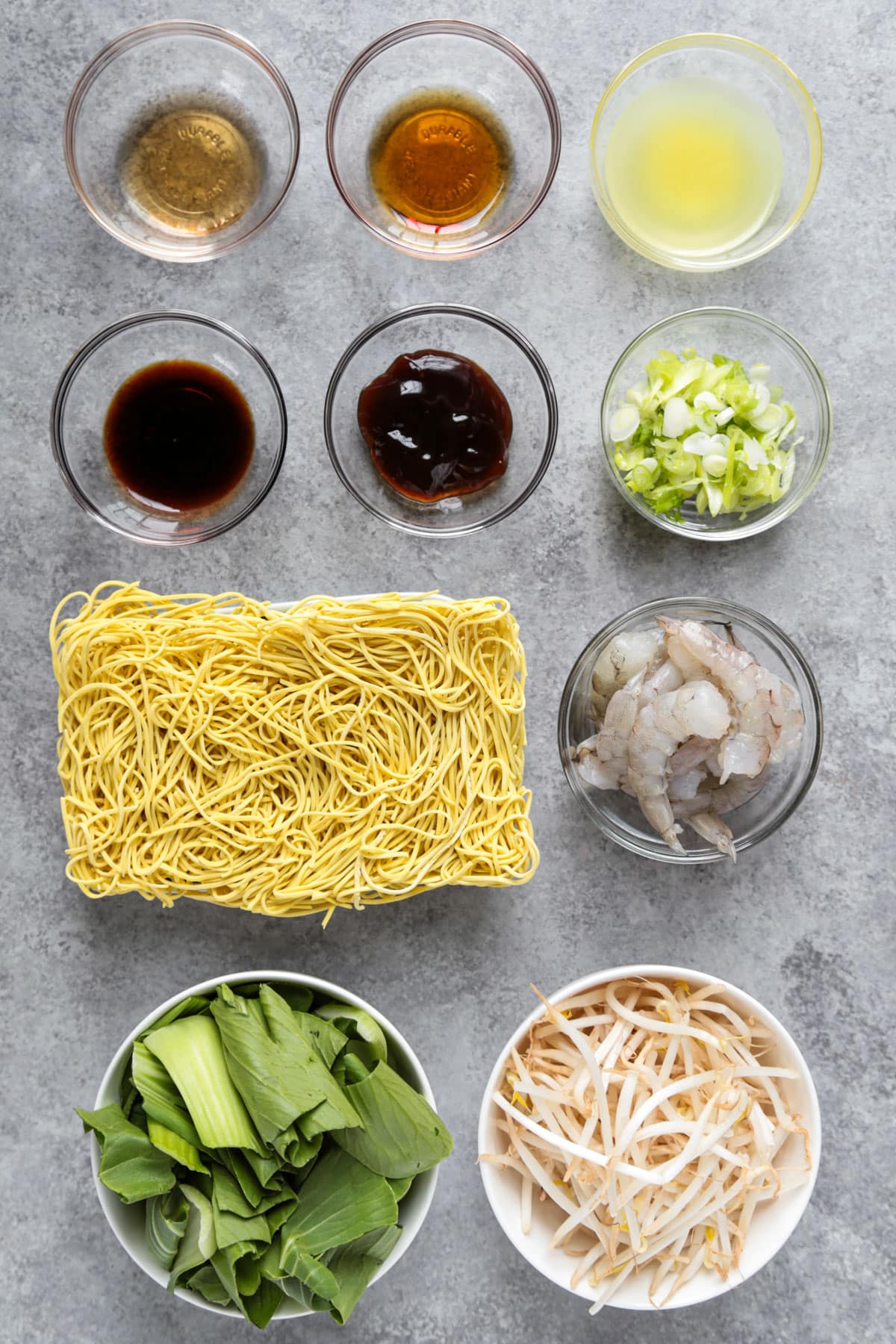
Ingredients
Scroll to the bottom of this page for the full recipe steps and measurements.
- Shrimp: Frozen or fresh. If it’s frozen, thaw shrimp in a bowl under cold running water. I always shell and devein shrimp before cooking.
- Cooking Oil: I use any neutral flavored oil. My defaults are grapeseed, peanut or vegetable oil.
- Chow Mein Noodles: These are Chinese wheat flour noodles with egg added. Chow mein is usually sold in dry bricks.
- Baby Bok Choy: I prefer baby bok choy because it’s tender and crisp. But feel free to use full sized bok choy if that’s what’s handy at the market. Either way, I chop this bigger-than-bite-sized. It wilts slightly as it cooks.
- Green Onions: AKA – spring onions or scallions.
- Bean Sprouts: Add these last, just before serving. In my mind, the perfect bean sprout in shrimp chow mein is still fairly crunchy.
Sauce Ingredients
I mix shaoxing wine with soy sauce, chicken broth, oyster sauce and a couple teaspoons of sesame oil. That’s it.
The flavors permeate and absorb into the noodles – but this isn’t a saucy noodle recipe. Chow mein should be fairly dry when served.
Chow mein is an easy recipe to get right. And that’s why I’m increasingly flummoxed when restaurants fumble the ball with this one. This recipe is foolproof. Bonus: I make it at home for a fraction of the price of takeout.
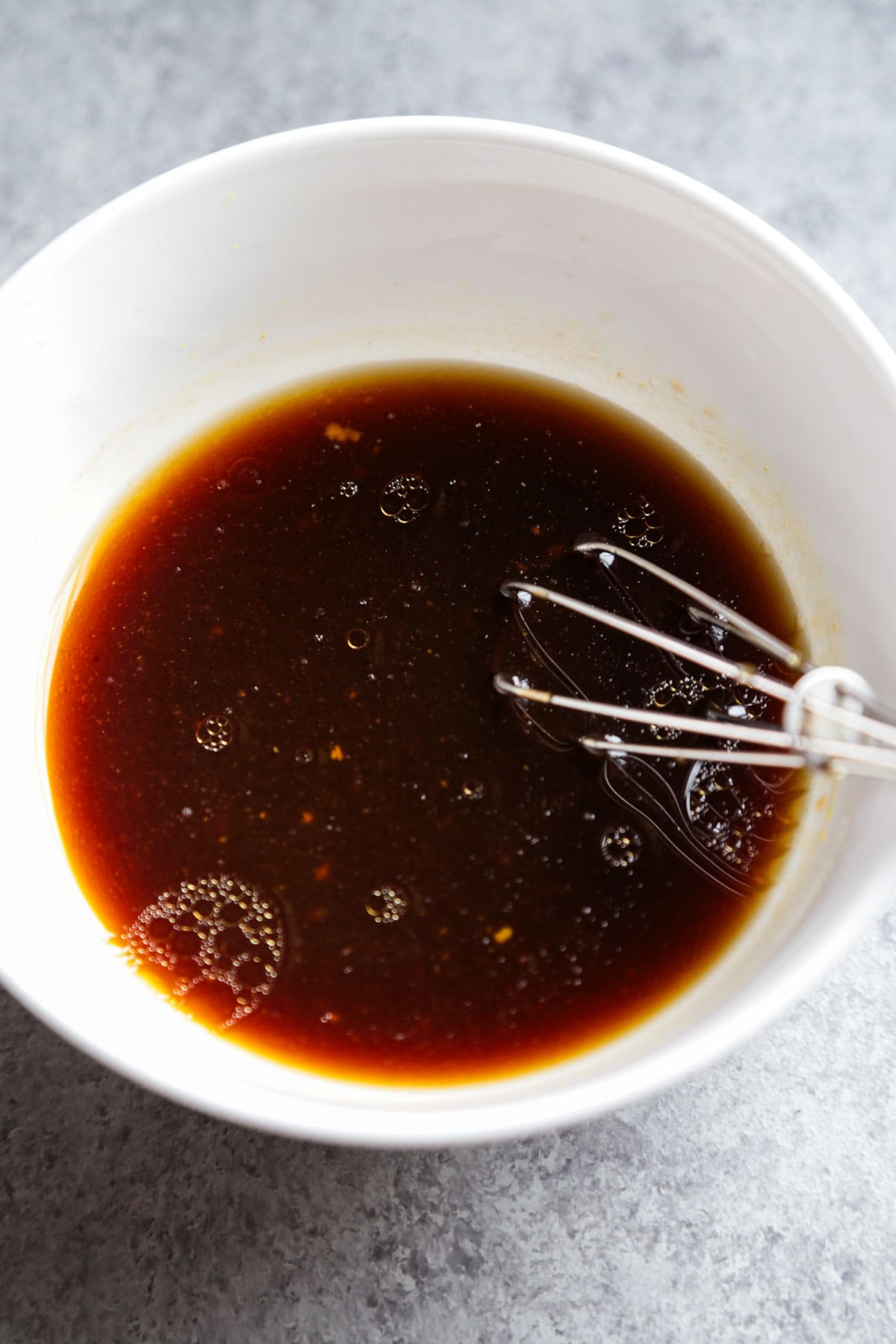
How To Make It
- Mix the sauce. Whisk well and set aside.
- Boil the noodles. Follow the timing instructions on the package and test doneness often. Drain well.
- Cook the shrimp. Heat a wok or deep skillet and cook the shrimp alone. Transfer the cooked shrimp to a plate and keep them handy.
- Assemble the stir fry. Start with the bok choy and green onions – then add the noodles, shrimp, sauce – and toss until well combined. Add the bean sprouts after the heat is off. Toss one last time and serve immediately.
When I stir fry, I use high heat and low cooking times. That way I can flash fry my ingredients in just a little oil. Veggies cook, but keep their crisp texture. And the dish as a whole tastes smokier.
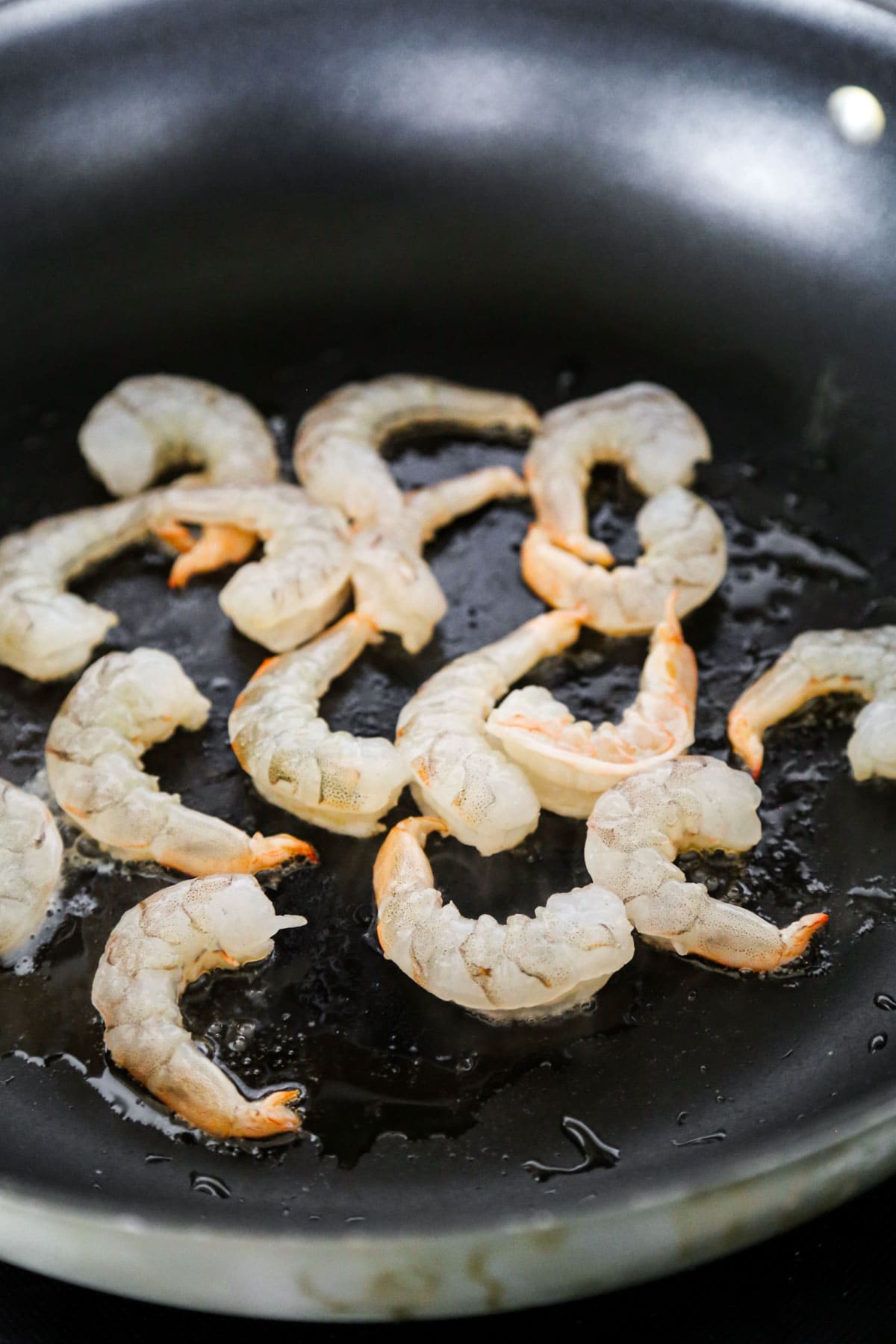
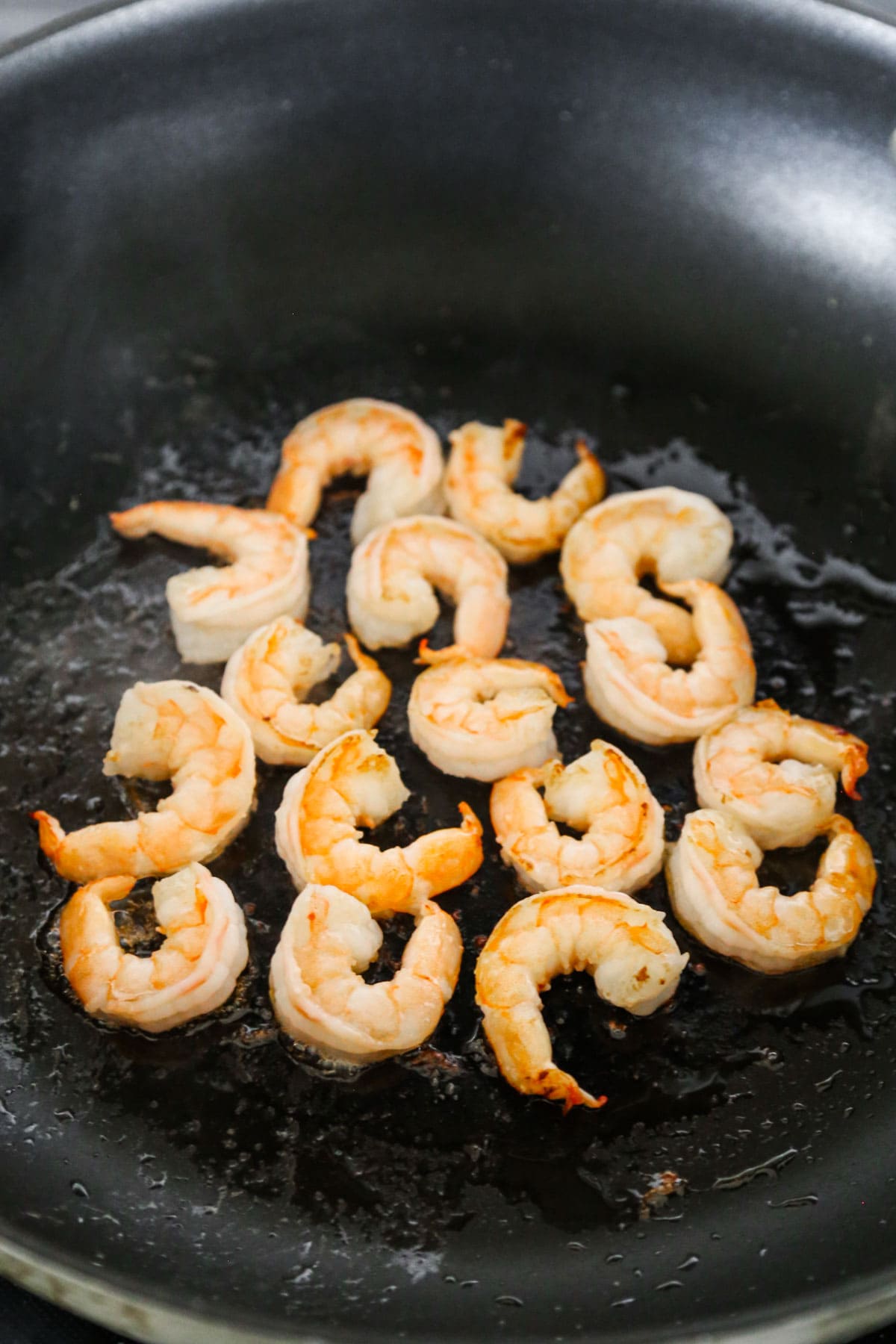
Expert Tip
Cook the shrimp separately from the noodles. There’s an important reason I cook the shrimp first, then remove them from the pan once they’re just shy of perfect. They’ll overcook if I keep them in the pan the entire time. Cooking them separately also allows the shrimp to have unimpeded contact with the hot cooking surface, without having to compete with other ingredients. They’ll be lightly charred on the outside and springy on the inside. I add them back to the pan a second time (when introducing the chow mein sauce), so they’re hot and full of flavor.
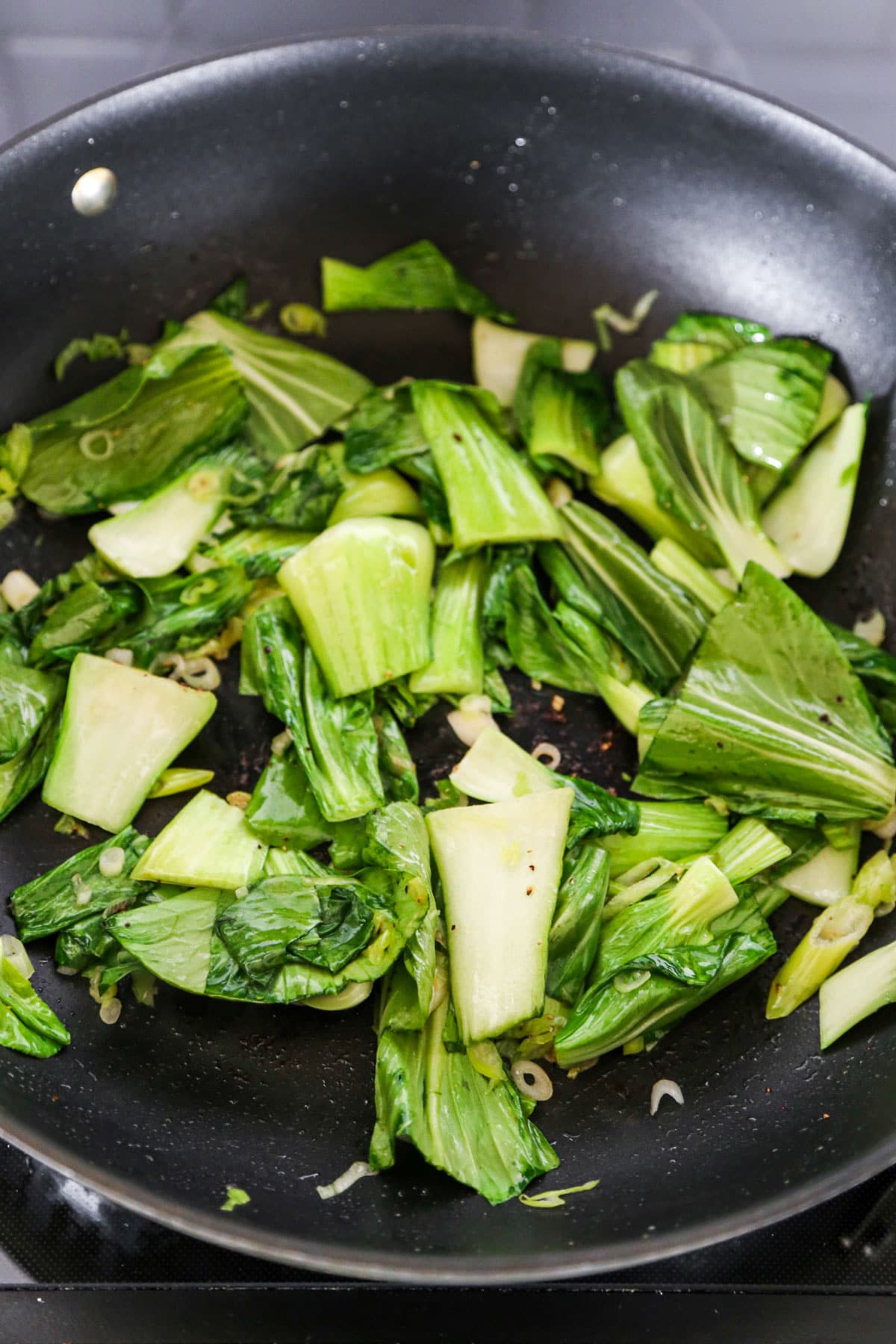
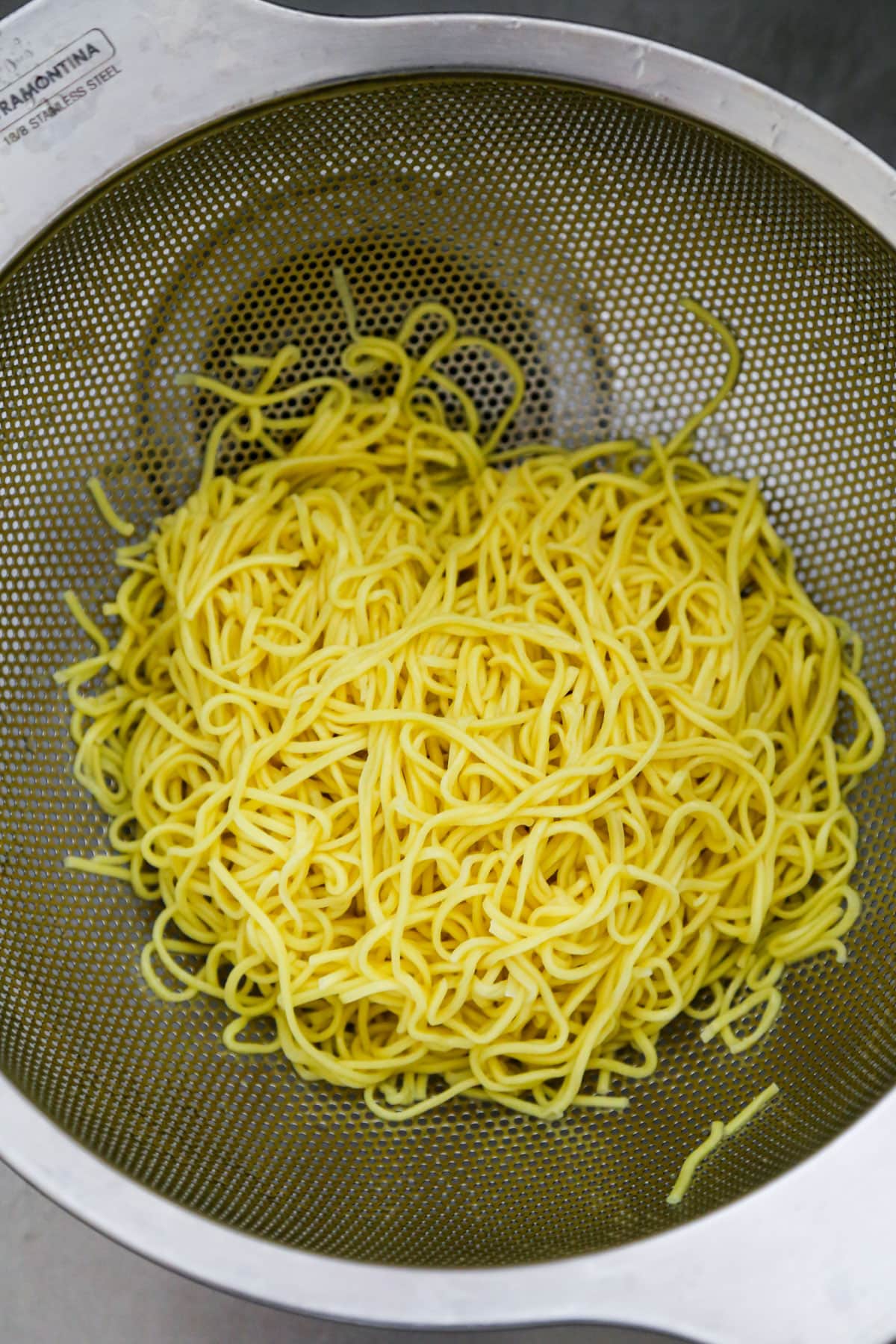
Recipe Variations
My shrimp chow mein is highly adaptable. Here are my simple suggestions for ingredient swaps and additions.
- Swap proteins. Chicken, tofu, beef or squid. There are no rules. And I make chow mein without protein all the time too.
- Make it spicy. There are the usual suspects like sriracha and sambal. But when I’m craving complex heat, I use my homemade hot Sichuan chili oil and go for broke.
- Use different veggies. What’s currently in the crisper? Use that. I always make sure to chop veggies the same size so they cook consistently.
- Make it vegetarian. Nix the shrimp – and use vegetable broth instead of the chicken broth. Boom, done.
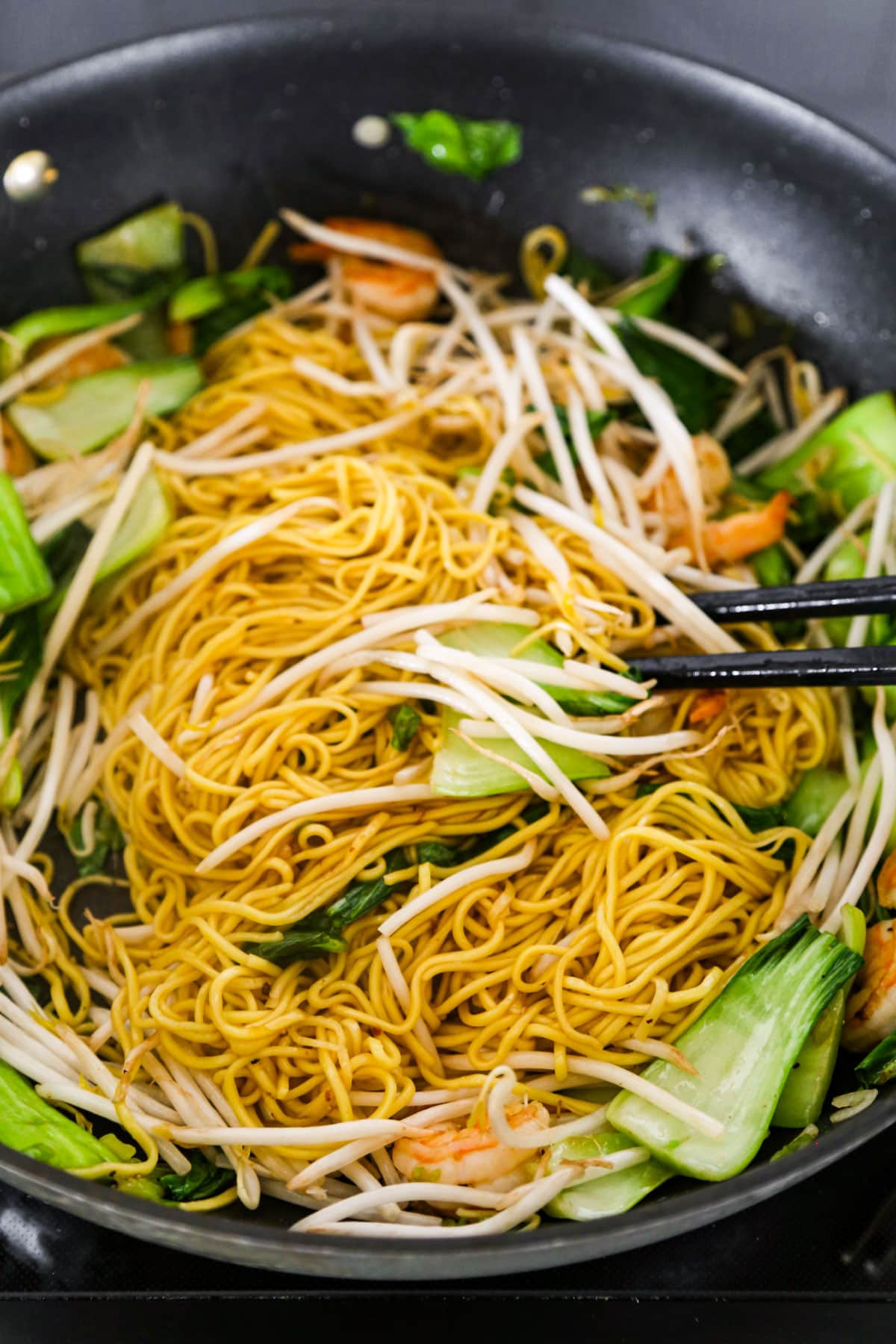
Storage and Reheating
Store leftovers in the refrigerator (covered) for up to 3 days. Reheat in the microwave – or in a hot pan on the stovetop with a little oil.
If the flavors weaken a bit in the fridge, I fix my leftovers with a dash of soy sauce and a few drops of sesame oil.
* While the chow mein noodles themselves can technically be frozen, the shrimp can not. In fact, I don’t recommend freezing leftover chow mein at all – since the texture of the noodles will be gummy once thawed. If you decide to freeze leftovers anyway, be sure to remove the shrimp beforehand.
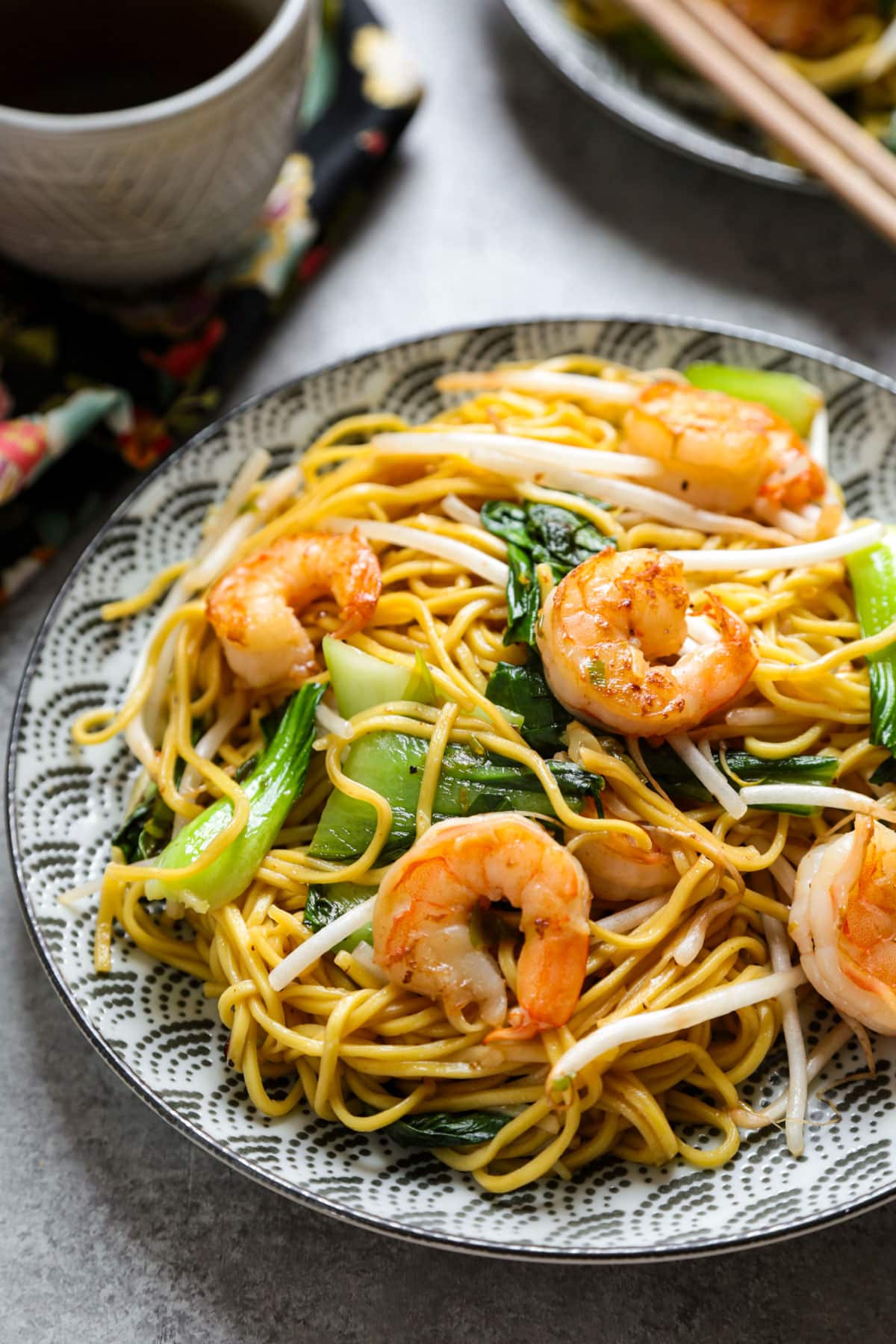
What I Serve With Shrimp Chow Mein
Shrimp chow mein is one of those things I’ll make a big batch of and devour bowl after bowl on the couch. When I’m whipping up a Chinese feast at home, here are some of my takeout favorites I’d rather make from scratch than order.
Some of my other favorite Chinese noodle recipes: tofu chow fun with watercress, pan fried noodles with chili crisp, spicy vegan Sichuan noodles, cold sesame noodles, vegan dan dan noodles, vegetable chow mein, fried noodles with soy sauce, Cantonese chow fun
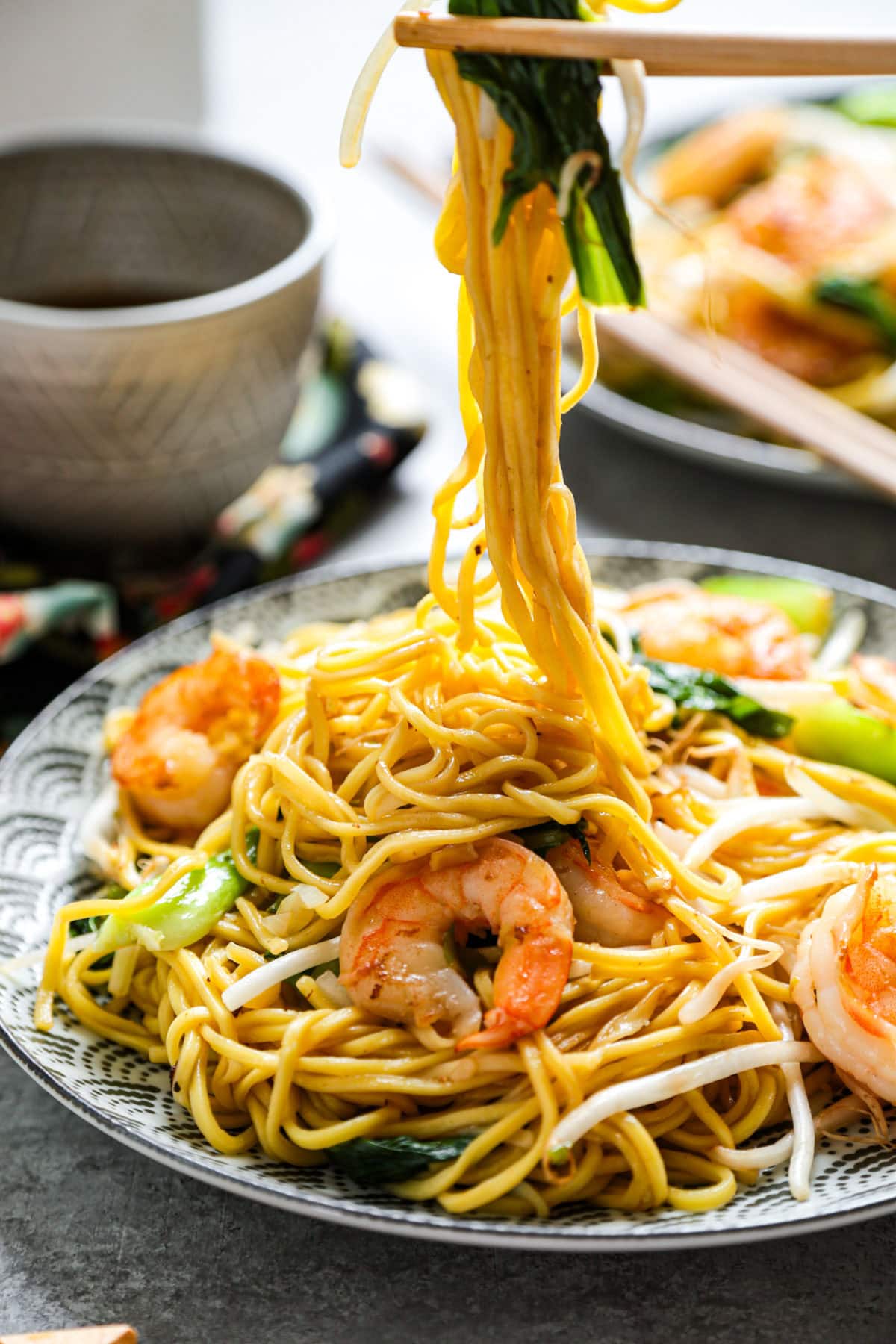
Frequently Asked Questions
Nope! Any deep skillet or frying pan will work. Don’t get too hung up on your kitchen tools for this one. I use a flat bottom wok (which is basically just a deep frying pan anyway).
They might be overcooked. When making chow mein, I use the cook timing instructions from the package as a baseline. But, once my noodles are boiling, I start testing doneness about two minutes before the package says they should be perfect. As soon as the noodles are al dente, I drain them – and try to assemble the dish soon after so they don’t clump up.
The stovetop heat may not be high enough. Stir frying this recipe on high heat is important. Veggies cooked on high heat cook quickly, while retaining their crunch. Cooking on medium or low heat will take longer – and essentially steam your ingredients.
Yes! Just use an equivalent amount of dry sherry.
Did you like this recipe? Are there changes you made that you would like to share? Share your tips and recommendations in the comments section below!
Print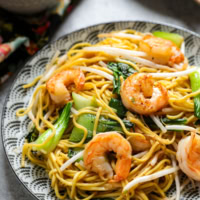
The Best Shrimp Chow Mein
- Prep Time: 15 minutes
- Cook Time: 10 minutes
- Total Time: 25 minutes
- Yield: 4 small servings 1x
- Category: Noodles
- Method: Stir fry
- Cuisine: Chinese
Description
My Shrimp Chow Mein recipe has loads of ‘wok hei’ and is packed Chinese vegetables and springy shrimp. Just 25 minutes from start to finish.
Ingredients
- 1/2 pound large shrimp (about 18 to 20 shrimp), thawed, peeled, and deveined
- 2 tablespoon neutral oil such as vegetable oil or peanut oil
- 6 ounces chow mein noodles
- 2 cups sliced baby bok choy or napa cabbage
- 3 green onions, thinly sliced on the bias (diagonally)
- 2 cups bean sprouts
- Salt and pepper, to taste
Chow mein sauce
- 2 tablespoon oyster sauce
- 1 tablespoon regular soy sauce
- 2 teaspoons shaoxing wine or dry sherry
- 3 tablespoons chicken broth
- 2 teaspoons toasted sesame oil
Instructions
- Make the chow mein sauce: Whisk the ingredients for the chow mein sauce in a bowl and set aside.
- Cook the noodles: Fill a medium or large pot with water and bring it to a boil. Add the chow mein noodles and cook according to the directions on the package (about 3 minutes). Drain the noodles and set them aside.
- Warm up the wok: Heat a wok or a deep nonstick skillet over high heat. When the wok is hot, add 1 tablespoon of oil and swirl it around to coat the surface evenly.
- Cook the shrimp: Add the shrimp and stir fry for 4 minutes, until the shrimp are cooked through. Transfer the shrimp to a plate and set aside.
- Cook the bok choy and green onions: Using the same wok over high heat, add the remaining tablespoon of oil and add the bok choy and green onions. Cook for 2 minutes.
- Return the noodles and shrimp to the wok and add the sauce: Add the chow mein noodles and cooked shrimp to the wok and pour the sauce over. Toss well to combine.
- Add bean sprouts and serve: Turn the heat off and add the bean sprouts. Lightly toss them and transfer the chow mein noodles to a serving plate. Serve immediately.
Notes
Cover and store leftovers in the refrigerator for up to 3 days.
Nutrition
- Serving Size: 1 serving
- Calories: 360
- Sugar: 5.5g
- Sodium: 971mg
- Fat: 16.2g
- Saturated Fat: 6.9g
- Unsaturated Fat: 2.7g
- Trans Fat: 0.3g
- Carbohydrates: 37.1g
- Fiber: 3.1g
- Protein: 17.4g
- Cholesterol: 91.5mg
